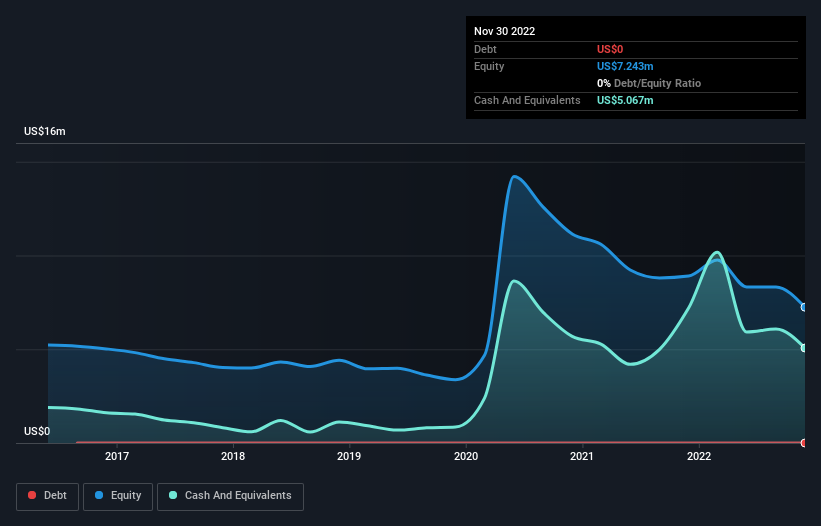- United States
- /
- Medical Equipment
- /
- NasdaqCM:BMRA
We're Keeping An Eye On Biomerica's (NASDAQ:BMRA) Cash Burn Rate

Just because a business does not make any money, does not mean that the stock will go down. For example, although software-as-a-service business Salesforce.com lost money for years while it grew recurring revenue, if you held shares since 2005, you'd have done very well indeed. But while history lauds those rare successes, those that fail are often forgotten; who remembers Pets.com?
Given this risk, we thought we'd take a look at whether Biomerica (NASDAQ:BMRA) shareholders should be worried about its cash burn. In this report, we will consider the company's annual negative free cash flow, henceforth referring to it as the 'cash burn'. First, we'll determine its cash runway by comparing its cash burn with its cash reserves.
Check out our latest analysis for Biomerica
When Might Biomerica Run Out Of Money?
A cash runway is defined as the length of time it would take a company to run out of money if it kept spending at its current rate of cash burn. When Biomerica last reported its balance sheet in November 2022, it had zero debt and cash worth US$5.1m. Importantly, its cash burn was US$4.8m over the trailing twelve months. Therefore, from November 2022 it had roughly 13 months of cash runway. That's not too bad, but it's fair to say the end of the cash runway is in sight, unless cash burn reduces drastically. You can see how its cash balance has changed over time in the image below.

How Well Is Biomerica Growing?
It was quite stunning to see that Biomerica increased its cash burn by 282% over the last year. While that certainly gives us pause for thought, we take a lot of comfort in the strong annual revenue growth of 52%. Considering both these factors, we're not particularly excited by its growth profile. Of course, we've only taken a quick look at the stock's growth metrics, here. This graph of historic revenue growth shows how Biomerica is building its business over time.
How Hard Would It Be For Biomerica To Raise More Cash For Growth?
While Biomerica seems to be in a fairly good position, it's still worth considering how easily it could raise more cash, even just to fuel faster growth. Issuing new shares, or taking on debt, are the most common ways for a listed company to raise more money for its business. One of the main advantages held by publicly listed companies is that they can sell shares to investors to raise cash and fund growth. We can compare a company's cash burn to its market capitalisation to get a sense for how many new shares a company would have to issue to fund one year's operations.
Biomerica's cash burn of US$4.8m is about 13% of its US$38m market capitalisation. As a result, we'd venture that the company could raise more cash for growth without much trouble, albeit at the cost of some dilution.
Is Biomerica's Cash Burn A Worry?
On this analysis of Biomerica's cash burn, we think its revenue growth was reassuring, while its increasing cash burn has us a bit worried. We don't think its cash burn is particularly problematic, but after considering the range of factors in this article, we do think shareholders should be monitoring how it changes over time. On another note, Biomerica has 4 warning signs (and 2 which make us uncomfortable) we think you should know about.
Of course Biomerica may not be the best stock to buy. So you may wish to see this free collection of companies boasting high return on equity, or this list of stocks that insiders are buying.
Valuation is complex, but we're here to simplify it.
Discover if Biomerica might be undervalued or overvalued with our detailed analysis, featuring fair value estimates, potential risks, dividends, insider trades, and its financial condition.
Access Free AnalysisHave feedback on this article? Concerned about the content? Get in touch with us directly. Alternatively, email editorial-team (at) simplywallst.com.
This article by Simply Wall St is general in nature. We provide commentary based on historical data and analyst forecasts only using an unbiased methodology and our articles are not intended to be financial advice. It does not constitute a recommendation to buy or sell any stock, and does not take account of your objectives, or your financial situation. We aim to bring you long-term focused analysis driven by fundamental data. Note that our analysis may not factor in the latest price-sensitive company announcements or qualitative material. Simply Wall St has no position in any stocks mentioned.
About NasdaqCM:BMRA
Biomerica
A biomedical technology company, engages in developing, patenting, manufacturing, and marketing diagnostic and therapeutic products for the detection and treatment of medical conditions and diseases worldwide.
Adequate balance sheet slight.


